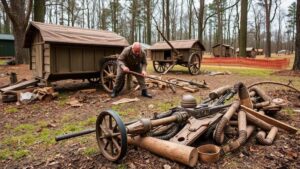Mining Early Logging Town Records for Clues to Hidden Equipment
Mining Early Logging Town Records for Clues to Hidden Equipment
In the quest for understanding the equipment and technology utilized in early logging towns, historical records are an invaluable resource. This article explores the significance of mining these records, specifically focusing on how they can unearth information about hidden equipment that may have been overlooked in contemporary logging discussions. By examining specific instances and employing a methodical approach, researchers can reveal insights into the operational practices of early logging communities.
Historical Context of Logging Towns
The logging industry has played a crucial role in the economic development of regions, particularly in the United States during the late 19th and early 20th centuries. Towns like Eureka, Montana, and Bend, Oregon, emerged as centers of activity, supported by vast timber resources. The desire for efficient timber extraction led to innovations in logging equipment, some of which have been documented but remain undiscovered in unorthodox records.
For example, in Eureka, Montana, logging operations began around 1880, preceded by a significant influx of Eastern European immigrants who introduced diverse logging techniques. These towns often kept detailed records, but modern researchers have yet to fully exploit these resources to understand the machinery used during this period.
Types of Records Useful for Equipment Discovery
Several types of records can provide insights into historical logging operations and the equipment used:
- Municipal records such as meeting minutes, ordinances, and town planning documents
- Business records from local lumber companies detailing purchases and equipment inventories
- Personal journals and diaries of logging workers and town residents, which may include descriptions of tools and techniques
- Newspaper archives covering local events, machinery showcases, and changes in logging practices
Mining the Records
Mining these records requires a systematic approach to identify relevant information. Researchers should consider the following steps:
- Establish targeted timelines: Focus on specific decades where logging peaked.
- Identify key figures: Locate influential individuals in the logging industry, such as company owners and equipment manufacturers.
- Use digital databases: Many historical records have been digitized and made available through archives. These databases can streamline the search for pertinent information.
For example, a study of the records from the Pacific Northwest between 1900-1920 revealed that steam-powered logging equipment, such as the Sawdust King, was frequently mentioned. By cross-referencing these mentions with local business records, researchers discovered a pattern of equipment usage aligned with significant lumber production spikes.
Real-World Applications
The findings from mining early logging town records can inform modern-day logging practices. Understanding the evolution of logging equipment helps researchers and industry professionals better appreciate the technological advancements that have affected productivity and worker safety over the years.
Plus, identifying forgotten techniques and equipment may stimulate interest in historical methods that could be revived for sustainable practices. For example, local woodlands management programs may benefit from rediscovered low-impact logging practices documented in personal diaries of early lumberjacks.
Addressing Potential Concerns
It is important to recognize that while mining early records can yield valuable information, several challenges may arise:
- Incomplete records: Many logging towns had irregular record-keeping practices, leading to gaps in data.
- Interpretation challenges: Understanding era-specific terminology may require additional research or expert consultation.
- Accessibility: Some historic records may only be available through physical archives, limiting wider access.
To mitigate these concerns, collaboration with historians, archivists, and local history enthusiasts can enhance data interpretation and provide a comprehensive view of historical logging practices.
Conclusion
In summary, mining early logging town records for clues to hidden equipment offers rich opportunities for research and understanding the development of logging technology. By carefully navigating historical documents and synthesizing their findings, researchers can uncover not only the equipment used but also the evolution of practices that shaped the logging industry. knowledge gained can pave the way for modern applications, fostering a deeper appreciation for historical techniques and their influence on contemporary logging practices.
As logging continues to evolve, studying its past becomes not only a celebration of history but also a necessary endeavor for sustainable practices in the future.


